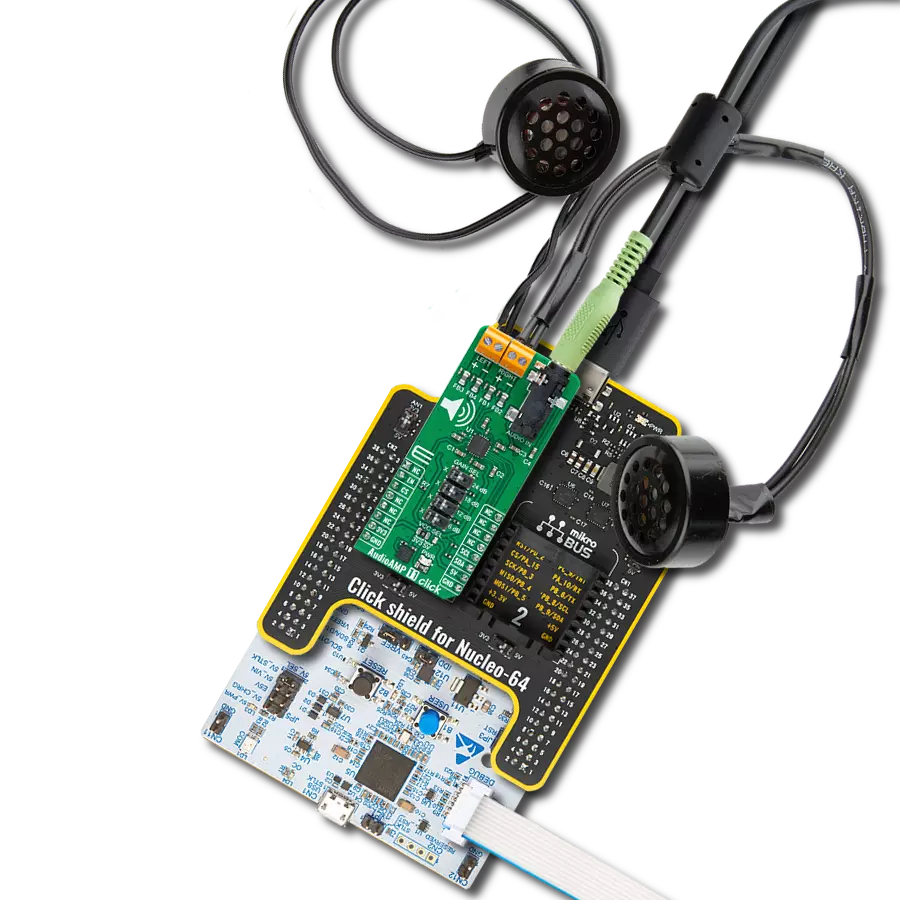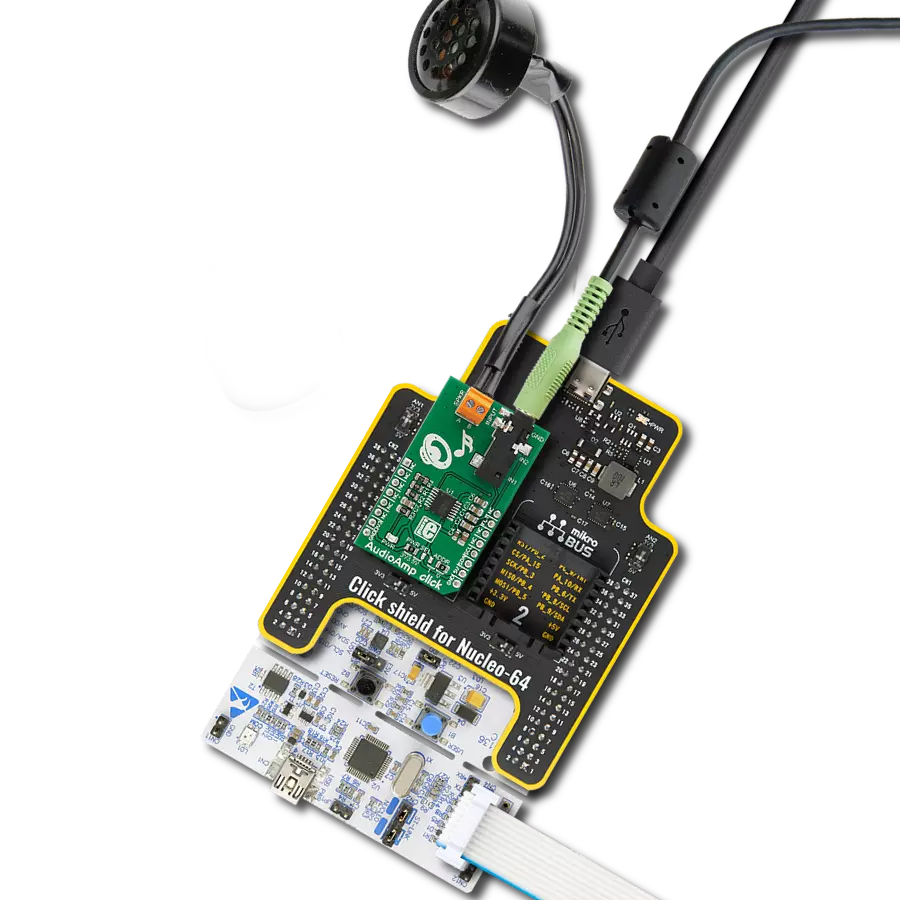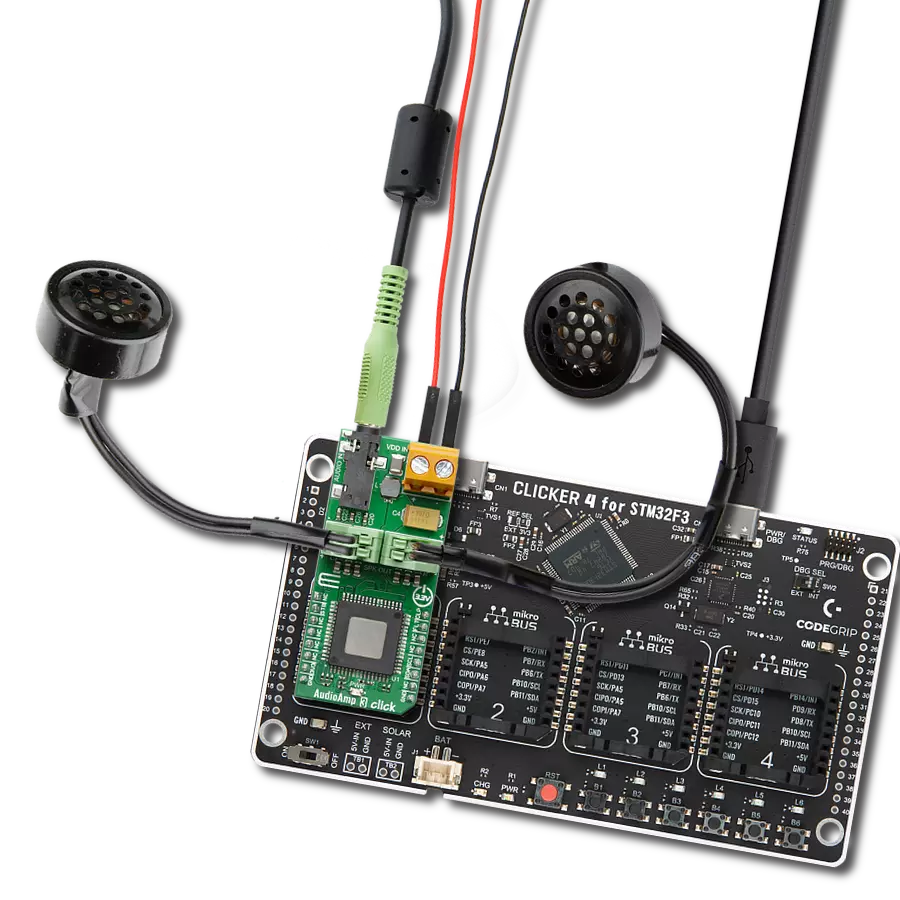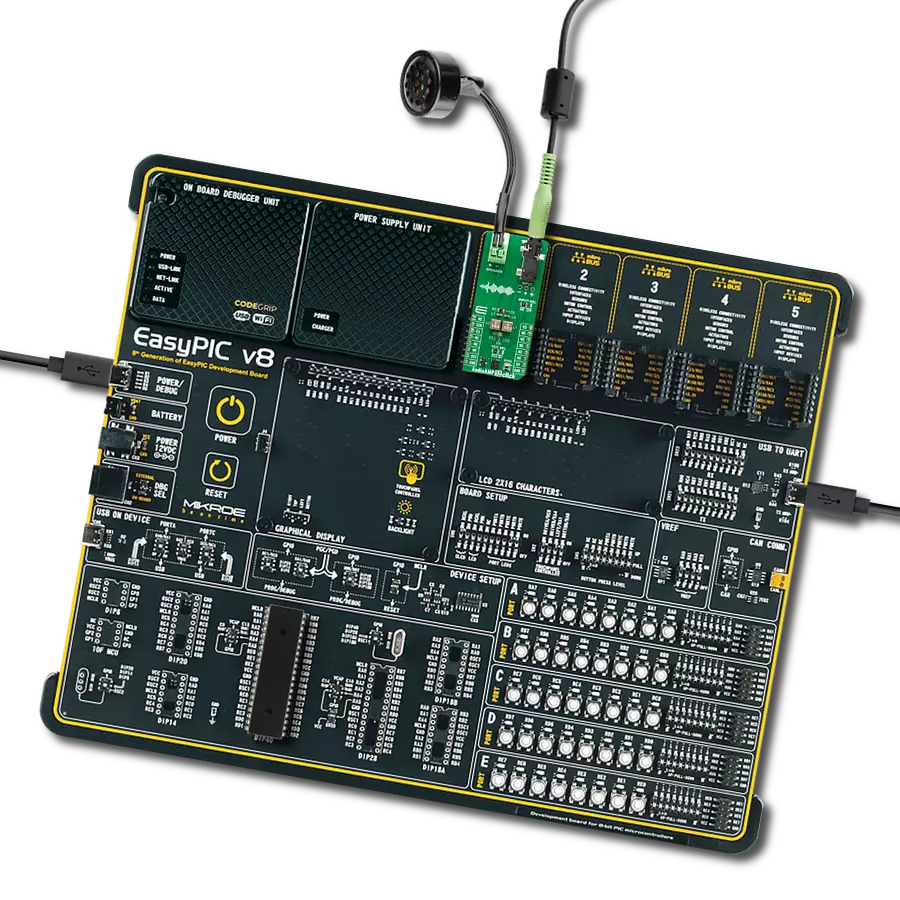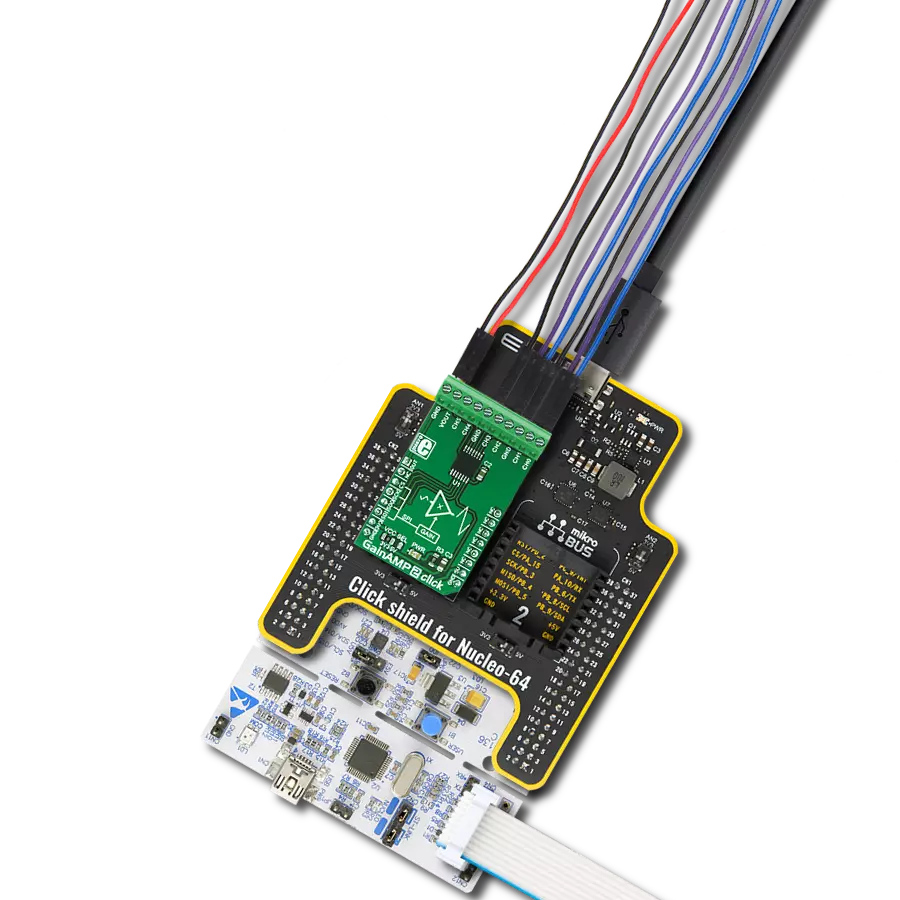Get ahead of the competition by integrating an advanced audio amplifier into your embedded solution
A
A
Hardware Overview
How does it work?
StereoAmp Click is based on two LM48100Qs, Boomer mono audio power amplifiers with output fault detection and volume control from Texas Instruments. The inputs of the amplifiers can be mixed/multiplexed to the device’s outputs. Each input has its own independent 32-step volume control. Each amplifier has short circuit and thermal protection, advanced click-and-pop suppression, and high PSRR. The StereoAmp Click features a 3.5mm audio jack as input and two pairs of screw terminals as output for connecting passive speakers. Each amplifier is used for one channel, left or right. The amplifiers are designed to drive a load differentially, a configuration better known as a bridge-tied load (BTL). BTL is an output configuration where the speakers are
connected (bridged) between two audio amplifier outputs. In a single-ended configuration, one side of the load is connected to the ground. Here both channels are connected, but one has an inverted signal. Compared to a single-ended configuration, BTL has two times more voltage swing across the load (speakers). The doubled voltage swing means four times more power to the speakers. This is ideal for applications and devices with lower supply voltage due to battery size. The output fault detection system can sense load conditions, protect the device during short circuit events, and detect open circuit conditions. The LM48100Q-Q1 output fault diagnostics are controlled through the I2C interface. In addition, the IC has an I2C selectable low-power shutdown mode that turns
off the device, reducing current consumption to 0.01μA. The StereoAmp Click uses the standard write-only 2-Wire I2C interface to communicate with the host MCU, supporting clock rates up to 400KHz. There are two fault detection pins, labeled FLL and FLR, according to a left or right channel. Those pins will go logic LOW if the fault condition occurs. This Click board™ can operate with either 3.3V or 5V logic voltage levels selected via the PWR SEL jumper. This way, both 3.3V and 5V capable MCUs can use the communication lines properly. However, the Click board™ comes equipped with a library containing easy-to-use functions and an example code that can be used, as a reference, for further development.
Features overview
Development board
Fusion for TIVA v8 is a development board specially designed for the needs of rapid development of embedded applications. It supports a wide range of microcontrollers, such as different 32-bit ARM® Cortex®-M based MCUs from Texas Instruments, regardless of their number of pins, and a broad set of unique functions, such as the first-ever embedded debugger/programmer over a WiFi network. The development board is well organized and designed so that the end-user has all the necessary elements, such as switches, buttons, indicators, connectors, and others, in one place. Thanks to innovative manufacturing technology, Fusion for TIVA v8 provides a fluid and immersive working experience, allowing access
anywhere and under any circumstances at any time. Each part of the Fusion for TIVA v8 development board contains the components necessary for the most efficient operation of the same board. An advanced integrated CODEGRIP programmer/debugger module offers many valuable programming/debugging options, including support for JTAG, SWD, and SWO Trace (Single Wire Output)), and seamless integration with the Mikroe software environment. Besides, it also includes a clean and regulated power supply module for the development board. It can use a wide range of external power sources, including a battery, an external 12V power supply, and a power source via the USB Type-C (USB-C) connector.
Communication options such as USB-UART, USB HOST/DEVICE, CAN (on the MCU card, if supported), and Ethernet is also included. In addition, it also has the well-established mikroBUS™ standard, a standardized socket for the MCU card (SiBRAIN standard), and two display options for the TFT board line of products and character-based LCD. Fusion for TIVA v8 is an integral part of the Mikroe ecosystem for rapid development. Natively supported by Mikroe software tools, it covers many aspects of prototyping and development thanks to a considerable number of different Click boards™ (over a thousand boards), the number of which is growing every day.
Microcontroller Overview
MCU Card / MCU
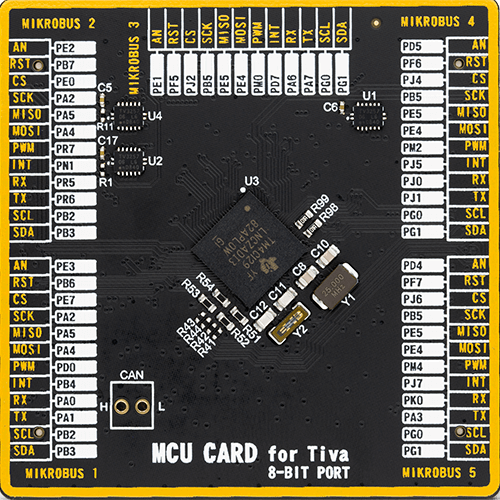
Type
8th Generation
Architecture
ARM Cortex-M4
MCU Memory (KB)
1024
Silicon Vendor
Texas Instruments
Pin count
212
RAM (Bytes)
262144
Used MCU Pins
mikroBUS™ mapper
Take a closer look
Click board™ Schematic

Step by step
Project assembly
Software Support
Library Description
This library contains API for StereoAmp Click driver.
Key functions:
stereoamp_set_power_on- This function set the power On of both channels by write to the Mode Control register address of LM48100Q-Q1 chip on StereoAmp Clickstereoamp_set_volume- This function set the volume of both channels to the Volume Control register address of LM48100Q-Q1 chip on StereoAmp Click
Open Source
Code example
The complete application code and a ready-to-use project are available through the NECTO Studio Package Manager for direct installation in the NECTO Studio. The application code can also be found on the MIKROE GitHub account.
/*!
* \file
* \brief StereoAmp Click example
*
* # Description
* This is an example which demonstrates the use of StereoAmp Click board -
* stereo amplifier and is ideal for battery operated devices or as a lab amplifier.
*
* The demo application is composed of two sections :
*
* ## Application Init
* Application Init performs Logger and Click initialization.
*
* ## Application Task
* This examples first set volume level 20 of 31 ( gain: 1,5 dB ) for 10 seconds.
* After that, we increase the volume to level 10 ( gain: -13,5 dB ) for the next 10 seconds.
* Results are being sent to the UART Terminal where you can track their changes.
*
* \author Mihajlo Djordjevic
*
*/
// ------------------------------------------------------------------- INCLUDES
#include "board.h"
#include "log.h"
#include "stereoamp.h"
// ------------------------------------------------------------------ VARIABLES
static stereoamp_t stereoamp;
static log_t logger;
// ------------------------------------------------------ APPLICATION FUNCTIONS
void application_init ( void )
{
log_cfg_t log_cfg;
stereoamp_cfg_t cfg;
/**
* Logger initialization.
* Default baud rate: 115200
* Default log level: LOG_LEVEL_DEBUG
* @note If USB_UART_RX and USB_UART_TX
* are defined as HAL_PIN_NC, you will
* need to define them manually for log to work.
* See @b LOG_MAP_USB_UART macro definition for detailed explanation.
*/
LOG_MAP_USB_UART( log_cfg );
log_init( &logger, &log_cfg );
log_info( &logger, "---- Application Init ----" );
Delay_ms ( 500 );
// Click initialization.
stereoamp_cfg_setup( &cfg );
STEREOAMP_MAP_MIKROBUS( cfg, MIKROBUS_1 );
stereoamp_init( &stereoamp, &cfg );
log_printf( &logger, "--------------------------\r\n" );
log_printf( &logger, " --- StereoAmp Click --- \r\n" );
log_printf( &logger, "--------------------------\r\n" );
Delay_ms ( 1000 );
stereoamp_default_cfg( &stereoamp );
Delay_ms ( 1000 );
log_printf( &logger, " Power On \r\n" );
stereoamp_set_power_on( &stereoamp );
Delay_ms ( 500 );
log_printf( &logger, "--------------------------\r\n" );
log_printf( &logger, " Set Volume: -80dB \r\n" );
stereoamp_set_volume( &stereoamp, STEREOAMP_GAIN_NEG_80dB );
Delay_ms ( 500 );
log_printf( &logger, "--------------------------\r\n" );
log_printf( &logger, " Enable Fault \r\n" );
stereoamp_enable_fault( &stereoamp );
Delay_ms ( 500 );
log_printf( &logger, "--------------------------\r\n" );
log_printf( &logger, " Enable Diagnostic \r\n" );
stereoamp_enable_diagnostic( &stereoamp );
Delay_ms ( 500 );
log_printf( &logger, "--------------------------\r\n" );
log_printf( &logger, " -- Initialization done --\r\n" );
log_printf( &logger, "--------------------------\r\n" );
Delay_ms ( 500 );
log_printf( &logger, "--------------------------\r\n" );
log_printf( &logger, " ----- Play Music ----- \r\n" );
log_printf( &logger, "--------------------------\r\n" );
Delay_ms ( 500 );
}
void application_task ( void )
{
log_printf( &logger, " Gain 1.5 dB \r\n" );
stereoamp_set_volume( &stereoamp, STEREOAMP_GAIN_1_5dB );
// 10 seconds delay
Delay_ms ( 1000 );
Delay_ms ( 1000 );
Delay_ms ( 1000 );
Delay_ms ( 1000 );
Delay_ms ( 1000 );
Delay_ms ( 1000 );
Delay_ms ( 1000 );
Delay_ms ( 1000 );
Delay_ms ( 1000 );
Delay_ms ( 1000 );
log_printf( &logger, "--------------------------\r\n" );
log_printf( &logger, " Gain -13.5 dB \r\n" );
stereoamp_set_volume( &stereoamp, STEREOAMP_GAIN_NEG_13_5dB );
// 10 seconds delay
Delay_ms ( 1000 );
Delay_ms ( 1000 );
Delay_ms ( 1000 );
Delay_ms ( 1000 );
Delay_ms ( 1000 );
Delay_ms ( 1000 );
Delay_ms ( 1000 );
Delay_ms ( 1000 );
Delay_ms ( 1000 );
Delay_ms ( 1000 );
log_printf( &logger, "--------------------------\r\n" );
}
int main ( void )
{
/* Do not remove this line or clock might not be set correctly. */
#ifdef PREINIT_SUPPORTED
preinit();
#endif
application_init( );
for ( ; ; )
{
application_task( );
}
return 0;
}
// ------------------------------------------------------------------------ END
Additional Support
Resources
Category:Amplifier


















